We’ve been looking at cookbooks lately. We recently acquired The Garden of Eating by blogging stars Chef Rachel Albert (The Healthy Cooking Coach) and Don Matesz (Primal Wisdom).
The first thing one notices about this book is the impressive amount of effort that was put into it – 7 years, I’m told. At 8.5” by 11”, 582 pages, it’s full of great recipes. Most pages present a single recipe plus variations.
The Garden of Eating synthesizes Paleo dieting with the foodways of traditional cultures. It begins with a discussion of Weston A Price’s survey of traditional cultures. From the Perfect Health Diet point of view, there are a few missing ingredients. There are recipes with potatoes or sweet potatoes, but no rice or taro. There are recipes with butter, but no cream. Still, potatoes and butter are a big step forward over some Paleo meal plans!
There are plenty of great dishes. We looked first for recipes with key Perfect Health Diet foods:
- Salmon and beef are favored in our diet for their low omega-6 content;
- Coconut milk and oil are favored for their ketogenic short-chain fats;
- Lemons are favored for reasons I’ll discuss in an upcoming series on dietary ways to enhance immune function;
- Herbs like oregano are favored for their antimicrobial activities in the gut.
We chose a recipe, “Herbed Salmon Cakes with Citrus,” that has a lot of these ingredients. Here is how we made it.
The Recipe
We doubled the size of the recipe, from 2 pounds salmon to 4 pounds, because we had a few college students at home for the holidays.
The recipe begins by pulverizing the fish in a food processor and combining it other ingredients in a bowl. We used a wok and here is the salmon with onion:
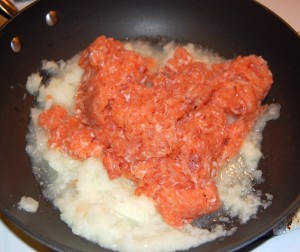
Other ingredients include fresh parsley leaves, minced celery, grated carrot, eggs, minced dulse leaf, herbs (basil, rosemary, thyme, oregano, lemon pepper), lemon zest, some starch, and some broth.
We made two substitutions: for the starch we used tapioca starch, while the recipe calls for shan yao, arrowroot starch, or powdered rolled oats; and we used lemon juice in place of the broth, where the recipe calls for chicken broth or filtered water.
Here are the ingredients mixed in our wok:
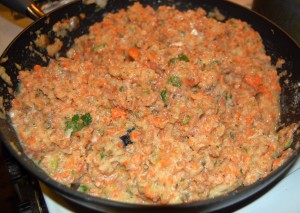
The next step was to divide into portions, form into balls, and press into patties. The patties are then covered and refrigerated overnight, or at least for several hours.
The recipe calls for lining a 13x9x2 baking pan with unbleached parchment or using muffin tins, and arranging the patties on a lightly oiled surface. We used aluminum foil on a cookie sheet and greased it with butter:
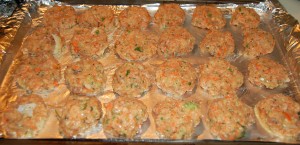
We cooked for 15 minutes at 350ºF until the patties were opaque throughout. Here’s how they came out:
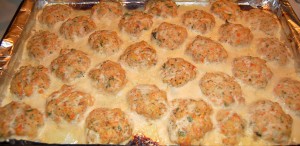
It appears our mix was a little too watery and bled a bit. Maybe the tapioca starch isn’t right for this recipe; or maybe we didn’t use enough seaweed. One of the variations was to replace the dulse with sea salt; we had a shortage of dulse and forgot to put in the sea salt, so perhaps that was the cause.
No matter; it tasted great. Here it is on a serving plate:
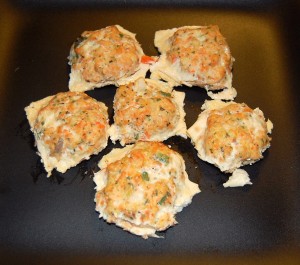
The recipe suggests dipping the cakes in one of the cookbook’s many sauces: Cajun Ketchup, Better Barbecue Sauce, herb infused Mayonnaise, or Tahini Tartar Sauce.
We found the cakes to be addictive: the more you ate the more you wanted another.
There’s a lot to be said for this recipe, apart from its healthy ingredients. The marinade takes away most of the fishy flavor, and the herbs cover the rest, so this may be palatable even to those who dislike salmon. Also, the cakes are a very portable form of salmon, easy to pack for lunch at work; they can be eaten as finger food.
Conclusion
We give two thumbs up to the recipe and the cookbook. Here’s a link to its Amazon page:











Thanks for posting this review of our book and the recipe! I’m glad you enjoyed the dish!
I have not worked with tapioca starch in many recipes so I’m not sure if the amount would need to be adjusted if using it to replace Shan Yao or rolled oats.
I hope you’ll try more recipes from our book. I look forward to diving into your book as well!
We might have released too much water by pureeing our onions in the food processor. Probably we should have squeezed water out of the patties.
Anyway, no worries, it tasted great. We’ll certainly be trying more recipes.
Paul,
I love your site, and great receipe. Would you mind posting the portions for each of the ingredients?
Hi Steve,
2 pounds wild salmon bellies, scraps, or boneless skinless fillets
1/2 cup finely minced or grated red or white onion
1/2 cup minced fresh parsley leaves
1/2 cup celery ribs and top leaves, finely minced
1 medium carrot, grated (about 1/2 cup)
2 large eggs or 4 egg whites, whisked
1 cup raw dulse leaf, sorted to remove shells, and minced with kitchen shears
1/2 teaspoon dried, crumbled basil
1/2 teaspoon dried, powdered rosemary
1/2 teaspoon dried, crumbled thyme
1/2 teaspoon dried, crumbled oregano
1/2 teaspoon lemon pepper, or to taste
Grated zest from 1/2 medium orange (colored part only) orzest from 1 lemon or 2 teaspoons dried orange rind or citrus powder
2 tablespoons powdered shan yao (Radix Dioscorea) or arrowroot starch or powdered rolled oats
3 tablespoons filtered water or preservative-free chicken stock or broth
1 1/2 tablespoons extra-virgin olive oil, unrefined coconut oil, ghee, or clarified butter
The dulse can be replaced with 1 teaspooon finely ground sea salt or 1 tablespoon tamari
I’ve seen recipes using tapioca starch, and have wanted to try it. You obviously find it an acceptable starch, but my question is whether it is ok to use in amounts greater than you would use as a thickener, for example in a baked good?
Hi Anna,
We’re still experimenting with safe starch cooking powders. We used tapioca starch just because we had it handy, we bought it originally for Mario’s Brazilian Cheese Puffs (http://perfecthealthdiet.com/?p=1151) and have continued buying it.
We don’t cook many baked goods so we don’t have much experience yet. Perhaps other chefs with more experience can give us tips?
first of all…we love the book! for us, the first step was eliminating toxins…that alone has pretty well solved my bowel problems. we are having a few problems figuring out what we DO eat, now that we are clear on what we DON’T eat. maybe you can help?
our biggest problem is that we can’t quite translate the recommendations about macro-nutrients into actual meal plans. we don’t need recipes as much as we need actual meal plans…examples of breakfast, lunch, dinner and snacks that would achieve the correct balance over the day (assuming you don’t actually have to hit the balance at every meal.
one of us still has dairy allergies (we are hoping this will clear up as bowel health continues to improve). we are both pretty squeamish about meat, so don’t eat organs or other body parts, other than muscle meat, so we are having to add a lot of fat…mostly using coconut oil for frying, spreading and melting on food. we love all the veggies so no problem there.
dinner is easy enough, and for snacks I am loving seaweed flavoured rice crackers with butter or coconut oil, and cheese (gary can’t eat the cheese, but is eating pate (the only form of organ meat he eats) Gary is taking left-over dinner for lunch, so that isn’t too bad either. What we need most is breakfast ideas (not a lot of cooking) and ideas for lunch at home. And then a few sample plans, showing how it all pans out over a day.
I am thinking that we are still getting too much protein and carbohydrate. Does going on this diet mean eating a much smaller volume of food? I am thinking this must be so, as calories from fat have no bulk…maybe we are still relying on protein and carbs for bulk too much?
Anyway, we are really hoping to get more clarity about actualy meal plans for a day, that result in the correct balance of macro-nutrients.
looking forward to your reply,
with appreciation, marla
p.s. my sister just sent me this amusing, crotchety rant which you will probably enjoy:
http://www.proteinpower.com/drmike/lipid-hypothesis/the-big-lie/?utm_source=feedburner&utm_medium=email&utm_campaign=Feed%3A+drmikenutritionblog+%28The+Blog+of+Michael+R.+Eades%2C+M.D.%29
Hi marla,
I’m glad you’re doing well!
We tend to eat leftovers for both breakfast and lunch — actually, we usually skip breakfast — so we eat much like Gary already does.
Some breakfast ideas:
Banana plus boiled eggs makes a good on-the-go breakfast.
Bacon and potatoes; eggs and potatoes.
Fruit or berries, rice crackers and pate would make a good breakfast.
We’ll obviously have to come up with much more extensive meal plans and food ideas. The main point is, you don’t need to restrict yourself to “breakfast” foods; you can eat anything as long as it’s healthy. Also, you don’t need to worry too much about macronutrient ratios. Get some carbs, some protein, and don’t avoid fats (except the omega-6 rich ones). Our carb and protein ranges are pretty wide, so almost any “real food” diet will fall in them.
Volume of food — that really depends on how many vegetables you choose to eat. You could eat almost a pound of potatoes, a pound of fruit or berries, a half-pound to a pound+ of meat, plus vegetables and oils. But if you eat rice, fatty meat, and not many vegetables, then the bulk of the diet is quite low. In that case you are dependent on vitamins for a lot of your nutrients.
We’ll be working away on the meal plans! Let me know if you find any meals particularly satisfying.
Best, Paul
I picked up the ingredients for these salmon cakes yesterday. We usually do salmon poached, then topped with homemade tzatzilki sauce. it will be nice to try something different. Thanks!
I am trying this tonight. Couldn’t find the seaweed you used, I picked up a refrigerated bag of salted korean seaweed. A good choice? I showed the woman in the Asian market the photos from this page and she suggested the korean seaweed. Also contemplating canned sockeye for $5/lb, cooking the onions and going from there.
Good luck, Matt! Let us know how it works out.
They came out great. Used the canned salmon, brown rice flour, and sauteed in coconut oil. The seaweed I found was mild, nice. Not sure what you are referring to w/r/t leftovers!
Though, hmmm…saute not good, high heat. Even with heat-stable coconut oil?
Sauteeing should be fine. Just stay well below the smoke point.
I see that Matt used canned salmon when making this recipe. Any concern that the Omegas 3 might be degraded/oxidized by the canning process and potentially long shelf time of this product? What about other methods of preservation, like pickling?
Thanks for any reply. Great book, btw!
I have the same question as anders, above.
Hi Anders, sorry I overlooked your comment.
Personally we eat fresh salmon and there are always concerns with old foods, preservatives, and with chemicals that line metal cans. However, I’m not that knowledgeable in how much actual damage is done, and it seems the food chemists can rarely agree either. Our senses of taste and smell are actually extremely sensitive, so if you cultivate those, they probably won’t guide you astray. But I don’t know for sure.
Best, Paul
Talking about books,
Paul, what do you think about Dr Tessa M. Pollard and her book?
Pollard, T. M. 2008. Western Diseases: An Evolutionary Perspective. Cambridge: Cambridge University Press.
Between Pollard and Staffan Lindeberg who do you think is the most knowledgeable and rigorous?
I’m searching for an european researcher with Phd. who is competent in this area.
Thanks ,
Gonçalo
Hi Goncalo,
I’m afraid I haven’t read Pollard’s book. It looks fascinating though – definitely worth reading.
I actually haven’t read Lindeberg’s book either, just his papers. Pal Jabekk gave a rather disappointing review a month or two back, here: http://ramblingsofacarnivore.blogspot.com/2011/04/lack-of-balls-or-lack-of-brains.html.
Best, Paul
Thanks Paul, it´s just that I need to find someone in Europe who can be a co-advisor in my Phd. thesis so I don’t know much more possibilities.
But I want someone who is not afraid of saying that fat after all is ok. Maybe Pollard is in a better position because she is not a doctor.
These were an interesting way to dress salmon in different clothes. I used Pamela’s gluten free flour as my binding agent and cilantro instead or parsley. I also left out the onion and celery as I didn’t have them, and it worked rather well – no issues with anything falling apart or weeping. But if I could remake these, I think I would add some mint, and perhaps some chili flakes or jalapeno. Mint and lemon are great friends, and I felt they needed some lightness. Additionally, despite all the herbs, I was yearning for a little heat and sweetness. This wasn’t my favorite, but it was a nice change to get my salmon down. Thanks for a not-too fishy option.